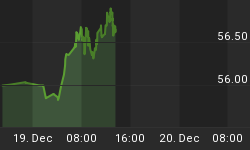The 2.8% monthly increase of new home sales in July was supposedly the surprise that drove Friday's rally (see Chart 1). Unlike re-sale homes, a new home sale is defined by the Commerce Department as a deposit taken or an agreement signed. The actual sale may or may not be finalized and the new home may never get built. The month of July is traditionally a slow month for home sales (see black bar in the middle), and the market's expecting lower figure. Therefore, in light of recent negative market condition, it wasn't a bad strategic move to spike the number. Similar strategy appeared to have worked quite well 2 years ago.

Chart 1
Toward the end of August 2005, the news release of a big 9% spike in new home sales in July 2005 (also see Chart 1) had caused similar market reaction right at an important support level (see Chart 2 below).

Chart 2
The new home sales number was left alone in 2006 because there's no need to do anything. In 2006, the market had already overcome the summer doldrums and moved on . By the time the report release date came around at the end of August, the S&P 500 Index had already moved above its recent support level (see blue arrow on Chart 3 below).

Chart 3
This and other recent maneuvers have made great improvements to the overall technical outlook. But the rapid pace of advance over just a short period had also taken us to a critical technical juncture, where both the S&P 500 Index and its 50-day EMA (Exponential Moving Average) had converged at the important 1480 resistance level on Friday (red boxes on Chart 4 below). Coincidentally, the 50-day EMA happened to be where the prior 3-day rally came to an abrupt halt (red down arrow in the upper pane of Chart 4).
The importance of the EMA is that it assigns more weight or relevance to more recent observations. What happened yesterday carries more weight than what happened 20 or 50 days ago. The EMA therefore reacts more quickly to recent price movement than the SMA (Simple Moving Average). The disparity between the EMA and the SMA and their crossovers usually signal potential trend reversal.

Chart 4
The bullish trend reversal in April was confirmed when the 50-day EMA moved above the 50-day SMA in mid April (blue circle on Chart 4). This bullish crossover also positively coordinated with the rising PVO (Percentage Volume Oscillator) in the lower pane of the chart. In June, the crossover forecasted a potential bearish trend reversal (red circle). By then, the fast-responding 50-day EMA had already fallen behind the 50-day SMA. The market eventually ran into correction in July, which was accentuated by the rising PVO. Since then, the 50-day EMA has not only been trailing the 50-day SMA, it also has been falling further behind (widening gap between the thick black curve and the gray curve).
We're right at an important resistance level where the 50-day EMA has fallen way behind the 50-day SMA and the PVO has also fallen off the cliff. That doesn't look too promising. The PVO appears to have reached an extreme low of under minus 5, relative to its recent history. The only logical move from here on is up. And, since what happened just 2 weeks ago indicates a possible strong resistance at the 50-day EMA level, the market may retreat from this resistance area before returning for more challenges. I'm concerned that this probable retreat may cause a spike in the PVO. If the PVO continues to rise after that while the market experiences further retreat, it could cause that other shoe to drop. This may then set off the 2nd phase of the correction.















